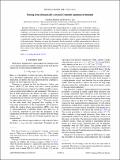| dc.contributor.author | Ruhman, Yehonatan | |
| dc.contributor.author | Lee, Patrick A | |
| dc.date.accessioned | 2017-12-06T18:13:30Z | |
| dc.date.available | 2017-12-06T18:13:30Z | |
| dc.date.issued | 2017-12 | |
| dc.date.submitted | 2017-06 | |
| dc.identifier.issn | 2469-9950 | |
| dc.identifier.issn | 2469-9969 | |
| dc.identifier.uri | http://hdl.handle.net/1721.1/112614 | |
| dc.description.abstract | Recently, Prakash et al. have discovered bulk superconductivity in single crystals of bismuth, which is a semimetal with extremely low carrier density. At such low density, we argue that conventional electron-phonon coupling is too weak to be responsible for the binding of electrons into Cooper pairs. We study a dynamically screened Coulomb interaction with effective attraction generated on the scale of the collective plasma modes. We model the electronic states in bismuth to include three Dirac pockets with high velocity and one hole pocket with a significantly smaller velocity. We find a weak-coupling instability, which is greatly enhanced by the presence of the hole pocket. Therefore we argue that bismuth is the first material to exhibit superconductivity driven by retardation effects of Coulomb repulsion alone. By using realistic parameters for bismuth we find that the acoustic plasma mode does not play the central role in pairing. We also discuss a matrix element effect, resulting from the Dirac nature of the conduction band, which may affect T[subscript c] in the s-wave channel without breaking time-reversal symmetry. | en_US |
| dc.description.sponsorship | Gordon and Betty Moore Foundation (Grant GBMF4303) | en_US |
| dc.description.sponsorship | United States. Department of Energy (Grant FG02-03ER46076) | en_US |
| dc.publisher | American Physical Society | en_US |
| dc.relation.isversionof | http://dx.doi.org/10.1103/PhysRevB.96.235107 | en_US |
| dc.rights | Article is made available in accordance with the publisher's policy and may be subject to US copyright law. Please refer to the publisher's site for terms of use. | en_US |
| dc.source | American Physical Society | en_US |
| dc.title | Pairing from dynamically screened Coulomb repulsion in bismuth | en_US |
| dc.type | Article | en_US |
| dc.identifier.citation | Ruhman, Jonathan and Lee, Patrick A. "Pairing from dynamically screened Coulomb repulsion in bismuth." Physical Review B 96, 23 (December 2017): 235107 © 2017 American Physical Society | en_US |
| dc.contributor.department | Massachusetts Institute of Technology. Department of Physics | en_US |
| dc.contributor.mitauthor | Ruhman, Yehonatan | |
| dc.contributor.mitauthor | Lee, Patrick A | |
| dc.relation.journal | Physical Review B | en_US |
| dc.eprint.version | Final published version | en_US |
| dc.type.uri | http://purl.org/eprint/type/JournalArticle | en_US |
| eprint.status | http://purl.org/eprint/status/PeerReviewed | en_US |
| dc.date.updated | 2017-12-05T18:00:23Z | |
| dc.language.rfc3066 | en | |
| dc.rights.holder | American Physical Society | |
| dspace.orderedauthors | Ruhman, Jonathan; Lee, Patrick A. | en_US |
| dspace.embargo.terms | N | en_US |
| dc.identifier.orcid | https://orcid.org/0000-0001-7809-8157 | |
| mit.license | PUBLISHER_POLICY | en_US |
| mit.metadata.status | Complete | |
